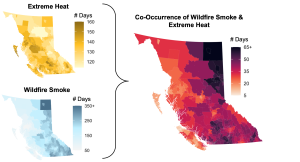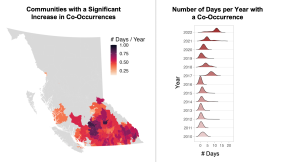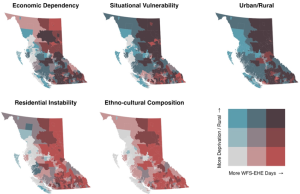
Compound Climate Hazards are on the Rise: The Co-Occurrence of Wildfire Smoke and Extreme Heat Events in British Columbia
– By Stephanie Cleland –

Climate change is increasing temperatures and changing weather patterns both across Canada and globally. As a result of these changes, many Canadians are experiencing, and will likely continue to experience, increased exposures to environmental hazards such as extreme heat and wildfire smoke. In recent years, communities across Canada have faced summers defined by severe heat waves and wildfires, including the record-breaking 2021 heat dome and 2023 wildfire season.
It is well established that exposure to either wildfire smoke or extreme temperatures can pose a significant threat to human health. However, most available research has identified the health risks of these climate hazards independent of one another, despite wildfire season occurring during the hottest months of the year. Only recently have studies begun to consider the potential health risks when wildfire smoke and extreme heat occur simultaneously. Early evidence indicates that simultaneous exposure to smoke and heat may have synergistic adverse health effects, resulting in a greater health risk than either exposure alone.
To understand which Canadian communities are most at risk of these amplified health effects in a changing climate, our study aimed to identify: 1) how often these climate hazards co-occur, 2) whether the frequency and intensity of these co-occurrences have changed over time, and 3) which communities are most exposed. We focused our analysis on a 13-year period (2010 to 2022) in British Columbia, a province which has long history of extreme wildfires and heat events.

Using daily data on fine particulate matter, smoke plumes, temperature, and humidity, we calculated the number of days in each community affected by both a wildfire smoke event and an extreme heat event. Communities were identified using dissemination areas, which are government-defined geographic regions with a population of approximately 400 to 700 people. In addition to evaluating the frequency, intensity, and trends in these compound climate hazards, we also explored the characteristics of the most exposed communities.
We found that between 2010 to 2022, all communities in British Columbia were exposed to at least 7, and upwards of 65, days with both a wildfire smoke and an extreme heat event, with communities experiencing an average of 2.8 co-occurrences per year (Fig. 1). We also identified significant year-to-year variability in the frequency and intensity of these compound climate hazards, with the highest exposures occurring in 2017, 2018, 2021, and 2022.
Additionally, we found that the frequency and intensity of co-occurring wildfire smoke and extreme heat events has increased over time, with communities experiencing an average of 4.5 co-occurrences per year between 2018 to 2022, compared to only 1 co-occurrence per year between 2010 to 2014. Across British Columbia, 42.5% of communities, representing approximately 1.9 million people, experienced a significant increase in their exposure to concurrent smoke and heat events (Fig. 2)
Notably, not all communities were equally affected by these compound climate hazards. Communities located in the south-central and northeastern regions of British Columbia tended to experience the most frequent and intense exposures. Almost all communities that experienced a significant increase in their exposure were located in the southern half of the province. The communities most exposed to co-occurring wildfire smoke and extreme heat events were primarily located in rural and remote regions, and many had lower socioeconomic status and a higher proportion of at-risk populations, such as those over the age of 65 (Fig. 3). These types of communities often have lower adaptive capacity, with reduced access to the resources necessary to follow public health guidance and mitigate exposure to climate-related hazards.

Our findings demonstrate that not only do wildfire smoke and extreme heat events frequently co-occur across British Columbia, but that they are also increasing in frequency and intensity in more susceptible, rural communities. Taken together with the emerging evidence of synergistic adverse health effects, our study underscores the critical need to increase the resilience and adaptive capacity of communities that are facing hotter and smokier summers. To do so, it is necessary to invest in effective and accessible public health strategies that account for both the complexity of compound climate hazards as well as the unique context, needs, and susceptibilities of the most at-risk communities.
Dr. Stephanie Cleland is an Assistant Professor and the Legacy for Airway Health Chair in Promotion of Lung Health in the Faculty of Health Sciences at Simon Fraser University and a Research Scientist at the Vancouver Coastal Health Research Institute. She holds a PhD and MSPH in Environmental Sciences and Engineering from UNC-Chapel Hill. Dr. Cleland’s research investigates how climate change-related environmental exposures, such as wildfire smoke and extreme heat, adversely impact human health.
british columbia, climate hazards, extreme heat events, Stephanie Cleland, wildfire smoke
